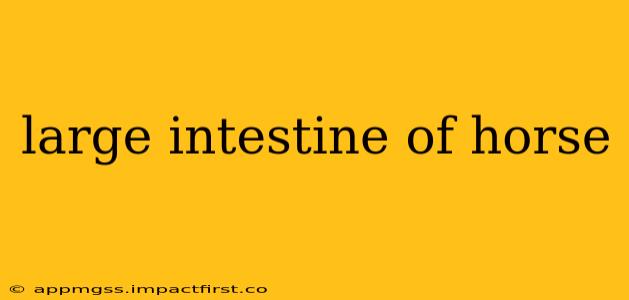The horse's large intestine is a fascinating and crucial part of its digestive system, playing a vital role in nutrient absorption and waste processing. Unlike humans and many other mammals, horses are hindgut fermenters, meaning the majority of their microbial fermentation occurs in the cecum and large colon. Understanding the intricacies of this system is essential for anyone involved in equine care, from veterinarians and farriers to owners and riders. This comprehensive guide will explore the anatomy, function, and potential problems associated with the equine large intestine.
What are the parts of a horse's large intestine?
The horse's large intestine is significantly larger than its small intestine and is composed of several key parts:
-
Cecum: This large, pouch-like structure is the first part of the large intestine. It's where microbial fermentation primarily takes place, breaking down cellulose and other plant fibers. The cecum houses a complex community of bacteria, fungi, and protozoa that work together to digest these indigestible materials.
-
Large Colon: Following the cecum, the large colon is divided into several sections: the right ventral colon, sternal flexure, left ventral colon, pelvic flexure, left dorsal colon, diaphragmatic flexure, and right dorsal colon. This complex arrangement allows for efficient mixing and fermentation of the ingesta.
-
Small Colon: This is the final section of the large intestine, responsible for water absorption and the formation of feces. It's much smaller in diameter than the large colon and cecum.
-
Rectum: The rectum is the terminal part of the large intestine, storing feces until defecation.
What is the function of the horse's large intestine?
The primary functions of the horse's large intestine are:
-
Microbial Fermentation: The cecum and large colon are the sites of extensive microbial fermentation. This process breaks down complex carbohydrates (like cellulose) into volatile fatty acids (VFAs), which are an important energy source for the horse. Vitamins K and B are also synthesized during this fermentation.
-
Water Absorption: The large intestine, particularly the small colon, plays a crucial role in water absorption. This prevents dehydration and contributes to the formation of well-formed feces.
-
Feces Formation: The large intestine is responsible for forming the feces that are ultimately eliminated from the body.
How long is a horse's large intestine?
The large intestine of a horse is remarkably long, approximately 10-12 feet in length. This extensive length reflects the importance of fermentation and water absorption in the equine digestive system. This extensive length contributes significantly to the overall digestive tract length of the horse.
What are common problems associated with a horse's large intestine?
Several health issues can affect the horse's large intestine, including:
-
Colic: Colic is a general term for abdominal pain in horses and often originates in the large intestine. Impactions (blockages) caused by dry feed or sand ingestion, as well as twists and displacement of the intestines (torsions and volvulus), are common causes of colic.
-
Cecal Impaction: A common type of colic, cecal impaction involves a blockage within the cecum, often resulting from a low-fiber diet or insufficient water intake.
-
Enteritis: This inflammation of the intestinal lining can affect different sections of the large intestine and can have various causes, including bacterial or parasitic infections.
-
Large Colon Displacement: Displacements of the large colon can occur, often leading to severe colic and requiring veterinary intervention.
Proper nutrition, regular veterinary care, and a well-managed environment are crucial for maintaining the health of a horse's large intestine.
What happens if a horse's large intestine is not functioning properly?
A malfunctioning large intestine can have severe consequences for a horse. Reduced nutrient absorption can lead to weight loss and weakness. Inability to process and eliminate waste can result in colic, dehydration, and even death if not addressed promptly. Early detection and intervention by a veterinarian are vital in managing these conditions.
Understanding the horse's large intestine is key to ensuring their health and well-being. This complex organ requires careful management through appropriate nutrition and preventative healthcare. By appreciating the intricate processes occurring within the large intestine, horse owners and caretakers can better recognize signs of illness and work proactively to maintain their equine partners' health.
